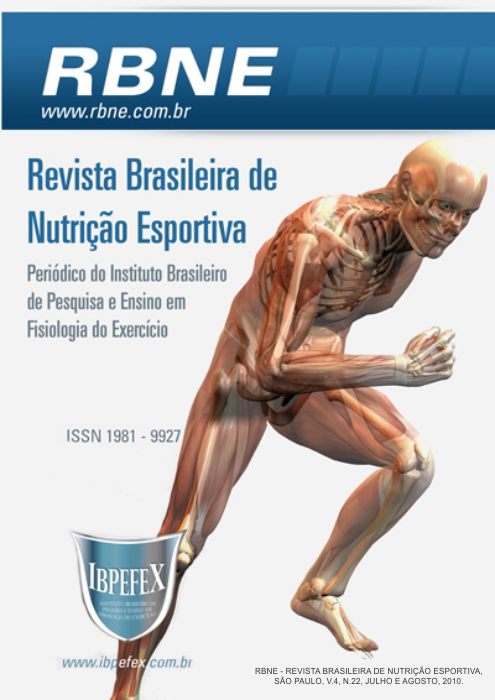Energetic and macronutrients Intake of soccer players
Abstract
The purpose of this study was to assess the energy intake and distribution of nutrients of professional football players of the Brazilian championship and compare them with the nutrition for athletes. The sample was composed of 30 athletes men aged 23,7 ± 4, 2 years, body mass of 77.7 ± 6, 3 kg, stature 180, 1, 4 ± 5 cm and body fat 11.6 ± 1.9%. The analysis of the adequacy of ingestion of energy and nutrients was carried out through the record of 24 hours and registry food three days. When comparing the nutrients in relation to the recommendations of Brazilian society of Medicine of the sport, we can say that the diet is low carbohydrate (51,9 4 ± 6.2% in record and 50.9 ± 6.4% in the registry), adequate protein (1.7 ± 0.5 g / kg in record and 1.8 ± 0.4 g / kg in the registry), and high fat (30.4 ± 5, 9% in record and 32,2 ± 6.2% in the registry). The total energy consumption, both the record (2810, 3 ± 427 0kcal) record food (3165 system, 3 ± 387, 5 kcal) indicate a diet hipocaloricin relation to the recommendation. It is concluded that the football players were insufficient intake of energy, and an imbalance in nutrients, with a greater percentage contribution of lipids from lower consumption of carbohydrates. However, the diet of athletes was considered adequate protein. The players need guidance nutrition to correct the imbalance in nutrients and energy deficit observed at the beginning of the season to provide better training in income and consequently improve performance senor.
References
American Dietetic Association –ADA.American College Sports Medicine –ACSM. Dietitians of Canada. Joint and Athletic performance. Med Sci Sports Exerc. Vol. 32. 2000. p. 2130-2145.
Biesek, S; Alves, L.A; Guerra, I. Estratégias de Nutrição e Suplementação no Esporte. 1. Edição, Editora Manole, São Paulo, 2005.
FAO/WHO/UNU. Energy and protein requirements: reporto f a joint expert consultation. Geneva (WHO Technical Report Series, 724).
Faulkner, J.A. Physiology of swimming and diving. Exercise Physiology. Baltimore: Academic Press, 1968.
Gomes, A.I.S.; Ribeiro, B.G.; Soares, E.A. Caracterização nutricional de jogadores de futebol de amputados. Rev Bras Med Esporte. Vol.11.Num.1.Niterói jan/fev 2005.
Guerra, I.; Soares, L.; Burini, R. Aspectos Nutricionais do Futebol de Competição. Rev Bras Méd Esporte. Vol. 7. Num. 6.nov/dez, 2001.
Kacht, I; Mcardle, W.D. Nutrição, exercício e saúde. 4.edição. Rio de Janeiro, Medsi, 1996.
Prado, W.L.; Botero, J.P.; Guerra, R.L.F.; Rodrigues, C.L.; Cuvello, L.C.; Dâmaso, A.R. Perfil Antropométrico e ingestão de macronutrientes em atletas profissionais brasileiros de futebol, de acordo com suas posições. Rev Bras Med Esporte.Vol.12.Num.2.Niterói mar/abr, 2006.
Reilly, T; Bangsbo, J; Franks, A. Antropometric andphysiological predispositions for elite soccer. Jounal of Sports Sciense. Vol.18. 2000. p. 669-683.
Sinning, W.E; e Colaboradores. Validity of generalized equations for body composition analysis in male athletes. Medicine and Science Sports and Exercise. Vol.17. 1985. p. 124-130.
Soares, E.A.; Ishii, M.; Burini, R.C. Estudo antropométrico e dietético de nadadores competitivos de áreas metropolitanas da região sudeste do Brasil. Rev Saúde Publica. Vol. 28. Num. 1. São Paulo fevereiro, 1994.
Sociedade Brasileira de Medicina do Esporte–SBME. Modificações dietéticas, reposição hídrica, suplementos alimentares e drogas: comprovação de ação ergogênica e potenciais de riscos para a saúde. Rev. Bras. Med.Esporte. Vol. 9. Num. 2.mar/abr. 2003.
Authors who publish in this journal agree to the following terms:
- Authors retain the copyright and grant the journal the right of first publication, with work simultaneously licensed under the Creative Commons Attribution License BY-NC which allows the sharing of the work with acknowledgment of the authorship of the work and initial publication in this journal.
- Authors are authorized to enter into additional contracts separately for non-exclusive distribution of the version of the work published in this journal (eg, publishing in institutional repository or book chapter), with acknowledgment of authorship and initial publication in this journal.
- Authors are allowed and encouraged to post and distribute their work online (eg, in institutional repositories or on their personal page) at any point before or during the editorial process, as this can bring about productive change as well as increase impact and impact. citation of published work (See The Effect of Free Access).






